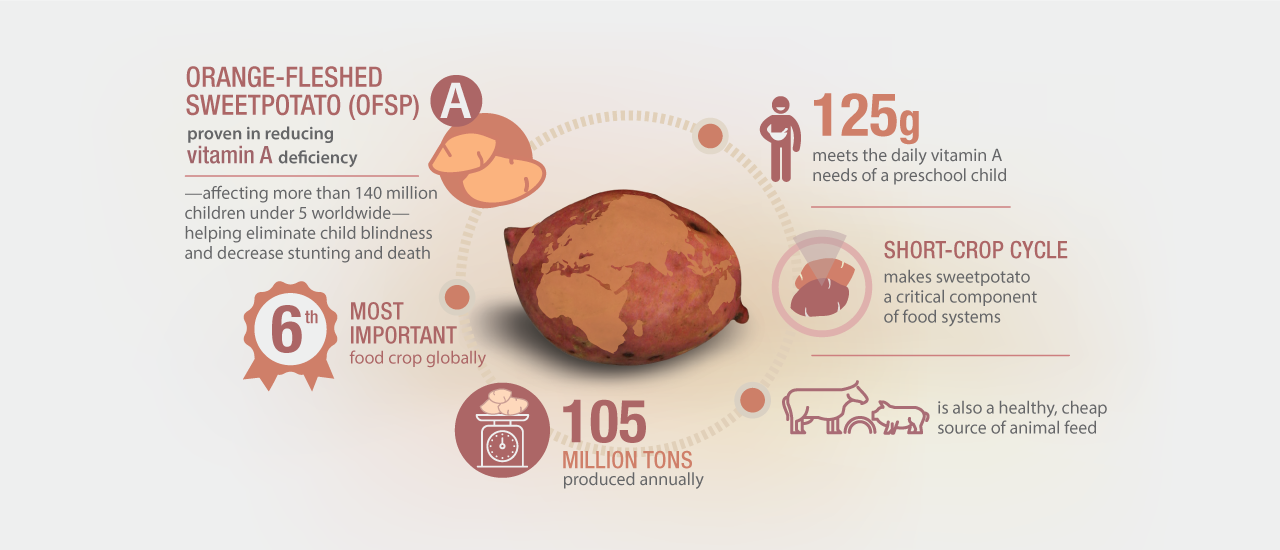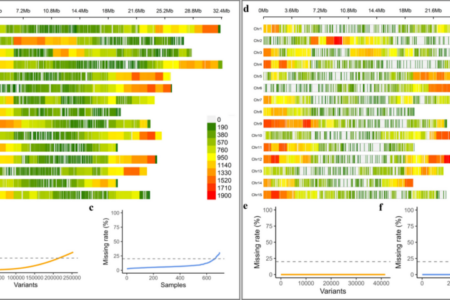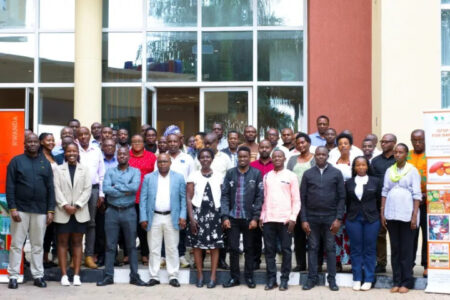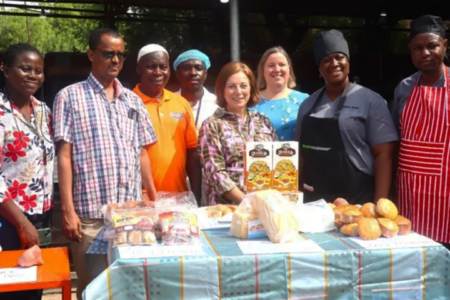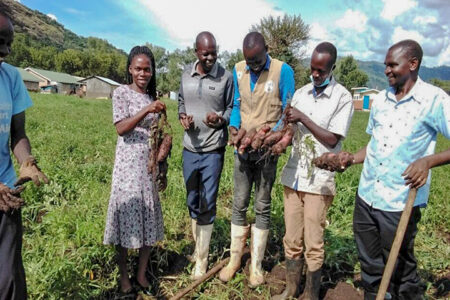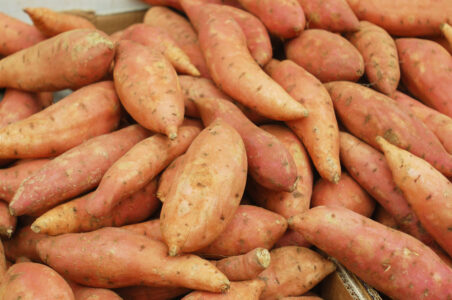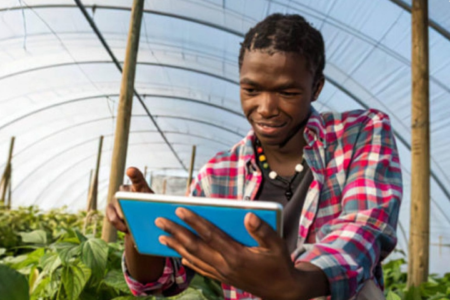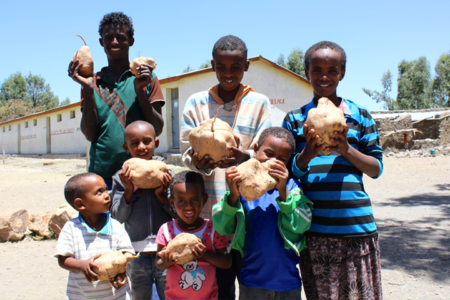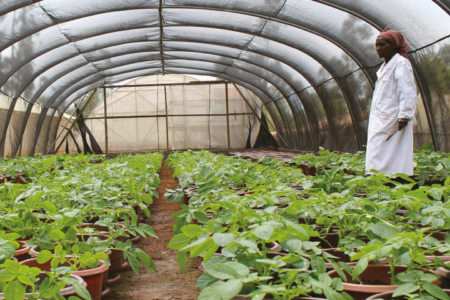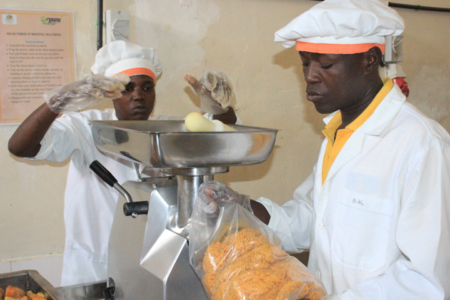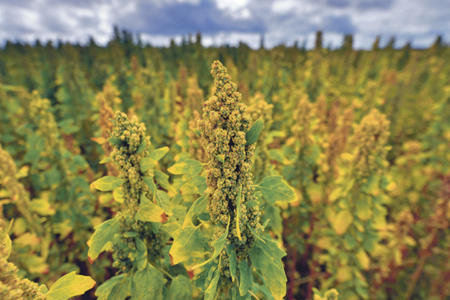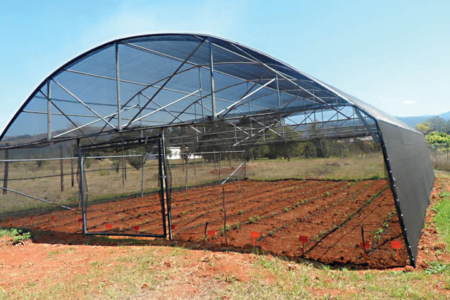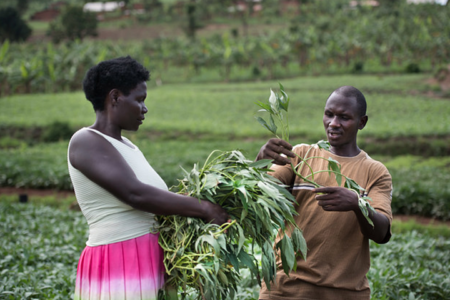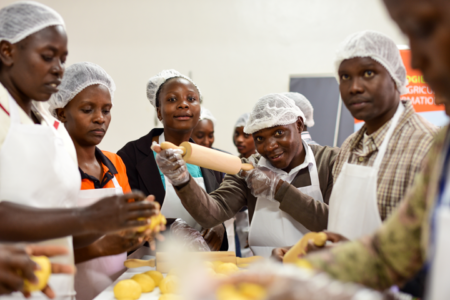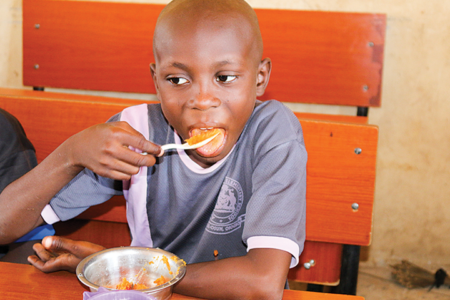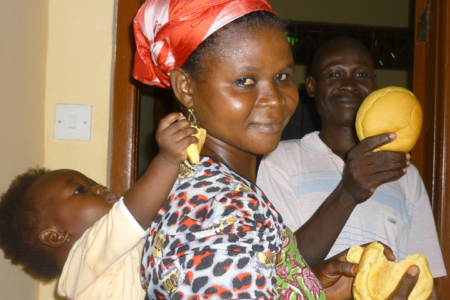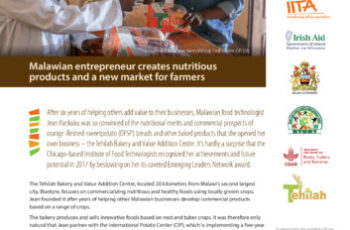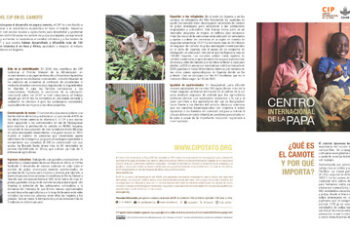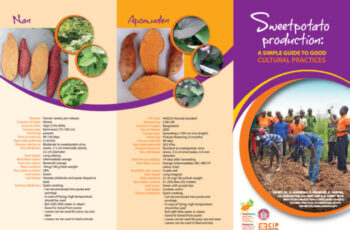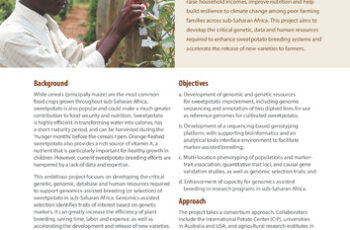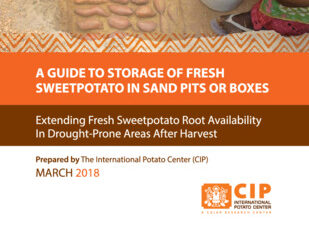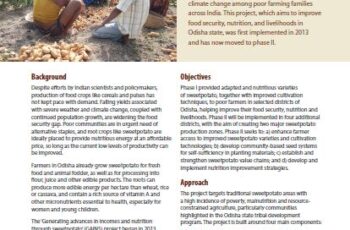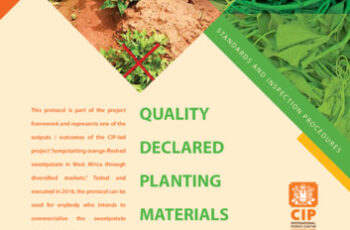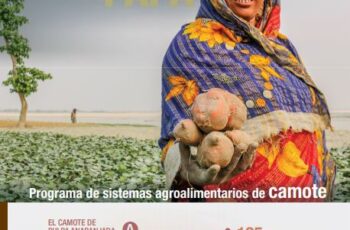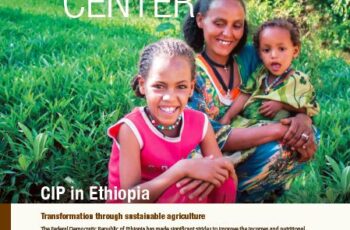SWEETPOTATO AGRI-FOOD SYSTEMS PROGRAM
The International Potato Center (CIP) responds to twenty-first century agricultural development challenges by organizing its work into three programs: Biodiversity for the future, and potato and sweetpotato agri-food systems.
Recent program achievements
Strategic Program objective
Sweetpotato will enable at least
15 million resource‐poor
households in Africa and Asia
to improve the quality of their diets and raise
their crop incomes by 15% by 2023.
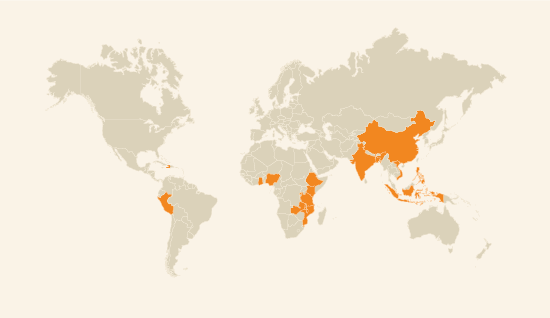
A hungry world
Today’s world is a hungry place. Some 870 million people are undernourished; the number of those who suffer from ‘hidden hunger’—deficiency of vitamins, minerals and other essential nutrients—is pushing two billion. Undernutrition has increased in many Asian and African countries in recent years and the number of underweight children has almost doubled since 1980. In developing countries, the effects of hunger and malnutrition on the rural poor can be devastating. Vitamin A deficiency (VAD), one of the most pernicious forms of undernourishment, can limit growth, weaken immunity, lead to blindness and increase mortality in children. Globally, 165 million children younger than 5 years suffer from VAD, mostly in Africa and Asia.
Huge potential
The vast majority of the world’s poor live in rural areas and depend on agriculture for their livelihoods. With the right technologies, small-scale farmers can adapt to the increasing threats posed by climate change, produce more nutritious and marketable food, and take advantage of economic opportunities created by growing demand among expanding and urbanizing populations.
Combating vitamin-A deficiency
CIP and partners have developed and disseminated dozens of biofortified, vitamin A-rich OFSP varieties in Africa and Asia, helping to raise the nutritional status and, to a lesser extent, the incomes of more than five million households. In 2016, three CIP scientists received the World Food Prize in recognition of their role in using biofortified crop to enhance nutritional outcomes. Biofortification focuses on increasing the pro-vitamin A content of new varieties through conventional breeding, boosting the availability of vitamin A for farm families and consumers. By promoting OFSP nutrition education at the community level, CIP-led work has made it a cost-effective and sustainable source of vitamin A for vulnerable populations, especially women and young children. By working with large food processors and fresh root traders in Africa, CIP has also facilitated the development of new value chains for OFSP, creating income-generating opportunities including for women and young people.
1. Genetic diversity: conservation, management and DNA sequencing
2. Breeding: nutritional improvement, increasead yields; climate resilience; participatory varietal selection
3. Seed system development: seed production, multiplication, distribution and quality control
4. Sustainable intensification: nutrition education, agronomic training and post-harvest handling and storage
5. Value chains: business training, improved product processing, enhanced market linkages
6. Inclusion: technologies and methods targeted particularly at women and young people
7. MEL: assessing and validating scaling tools and impact assessment methods
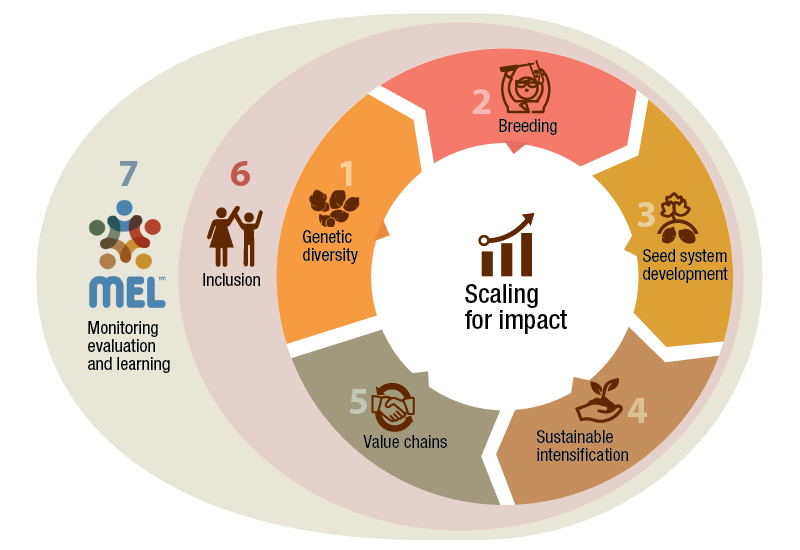
Research-for-development program products
The sweetpotato agri-food systems program is made up of a portfolio of research-for-development products.
Working through regional breeding hubs in Africa and Asia, CIP and partners accelerate and enhance the breeding of sweetpotato varieties with locally important traits—such as virus and drought resistance, vine survival, high dry matter, low sugar, salinity tolerance, weevil resistance or avoidance, early maturity, and increased vitamin A and iron-rich content. Work to date has enhanced nutritional outcomes and, in responding to consumer demand, has generated income opportunities by linking small-scale growers to commercial processors, such as bakeries.
Partnering with advanced research institutions, CIP enhances understanding and application of sweetpotato genomics (i.e. the structure, function, evolution and mapping of the sweetpotato’s genetic make-up) to breeding, such as marker-assisted breeding, to accelerate the development and release of biofortified, climate-smart and consumer-preferred sweetpotato varieties. This includes protocols for precision genotyping and phenotyping (observable physical and biochemical characteristics) for disease resistance, heat and drought tolerance, yield and other important traits. Standardized data collection and management facilitates decision-making; genome-wide association studies improve breeding value assessments and accelerate gains through better defined product profiles.
To achieve the full potential of OFSP, researchers use innovative approaches to upgrade both farmer-based and commercially-oriented seed systems, while emphasizing employment and income opportunities for woman and young people. CIP research facilitates market-driven production of quality planting materials (cuttings) through the development of new technologies and business models—particularly public-private partnerships—to enhance vine multiplication and conservation. This includes next-generation disease diagnostic tools for affordable and effective quality control in decentralized seed systems.
This product builds on the deployment of sweetpotato varieties with improved drought, heat and salinity tolerance, contributing to the climate-resilience of farming systems. By optimizing the rotation and association with other crops, CIP uses climate-smart sweetpotato to increase agri-food system resilience, adaptation to climate change and disaster recovery. Systems assessment research enhances understanding not only of abiotic (physical rather than biological) risks but also of how climate change effects the evolution of virus pressure and other pests and diseases.
Where crop–livestock integration is important, CIP develops sustainable options for the use of dual-purpose OFSP varieties that produce both animal feed (fresh vines, silage, reject roots) and food (roots and fresh leaves) for people. Measures are taken to ensure that these innovations contribute to sustainable livelihoods for men, women and young people.
Scientists take an integrated agriculture, nutrition, health, education and marketing approach to the promotion of biofortified OFSP. Working closely with specialized partners, CIP uses up-to-date knowledge to foster and study behavioral change to increase OFSP consumption. The evidence base for this encompasses diverse nutrition and food consumption scenarios and approaches for effecting lasting change in the behavior of consumers , caregivers, farmers and traders, as well as providing guidance for policymakers and the design of nutrition training and behavior change initiatives; this pioneering work offers strategies for large-scale adoption of biofortified crops.
CIP has developed models, technologies and tools for integrating OFSP into multiple value chains: from community‐based agriculture to higher value urban markets for bakery products and nutritious snacks. Scientists focus on the sensory acceptability (taste, sight, smell, feel) and nutritional content of an increasing range of sweetpotato products in different market and dietary contexts. The technical and organizational tools developed enable stakeholders to better manage the perishability of OFSP roots, create business opportunities for using them, and promote OFSP as a healthy and nutritious food.
Research on partnerships, innovation systems and policies is generating organizational models, guidelines and evidence-based policy recommendations supporting the large-scale adoption of OFSP. This product enhances understanding of the factors driving institutional innovations, including concepts of scaling readiness—e.g. from a technological or environmental perspective—and successful multi-stakeholder and public-private partnerships schemes to foster wide-scale impact.
Scientists have developed methods for assessing the impact of system changes in sweetpotato-related technologies and approaches—paying close attention to system productivity, sustainability, resilience, gender and youth equity, and adoption by farmers and agricultural organizations. These approaches are also used to assess food system vulnerability and interventions to improve food and nutritional security and the climate resilience of agriculture. Macro and micro foresight model analyses improves understanding of the adjustments needed in methods and metrics for forecasting and assessing actual impact, helping sweetpotato research respond to broader societal targets, such as the United Nation’s Sustainable Development Goals.
News categorized from the Sweetpotato agri-food systems program
Projects from the Sweetpotato agri-food systems program
Publications from the Sweetpotato agri-food systems program




